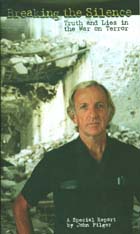
Breaking the Silence: Truth and Lies in the War on Terror 2003
Distributed by Bullfrog Films, PO Box 149, Oley, PA 19547; 800-543-FROG (3764)
Produced by Christopher Martin for Carlton Television
Directed by John Pilger
VHS, color, 52 min.
Sr. High - Adult
Human Rights, Middle Eastern Studies
Date Entered: 05/05/2004
Reviewed by Brian Falato, University of South Florida Tampa Campus LibrarySince the attacks on the World Trade Center and the Pentagon in September 2001, the United States has conducted major military campaigns in Afghanistan and Iraq, toppling the leadership of those two countries in the process. The justification for these actions was that Osama bin Laden, the acknowledged leader of the Sept. 11 attacks, was being sheltered in Afghanistan, and that Iraqi leader Saddam Hussein supported bin Laden’s terrorist organization Al-Qaeda, and had weapons of mass destruction (WMD) that could be used against the United States or other countries. As of April 2004, Bin Laden is still at large, and Hussein’s WMDs have not been uncovered. The rationale for the Afghanistan and Iraq invasions is being questioned, and some even feel that the Bush administration’s actions also can be called terrorism.
British reporter John Pilger is among those who feel this way. In Breaking the Silence, produced for Carlton Television in England, Pilger speaks of “the rise and rise of rapacious imperial power” and “the terrorism that doesn’t speak its name because it’s our terrorism.” He states that more than 3,000 civilians were killed during the bombing of Afghanistan, and that up to 10,000 civilians may have died in the war in Iraq. Furthermore, Pilger says, U.S. actions against the Taliban government of Afghanistan and the Hussein administration in Iraq are hypocritical. America provided funds and arms to Taliban members when they fought against the former Communist government of Afghanistan, and it considered Hussein an ally at one time and allowed American companies to sell him material that could be used to make weapons of mass destruction.
The idea that the U.S. is using the terrorism threat as a ruse to justify its actions is backed up by interviews with former intelligence officers in the U.S. and Australia. Bush administration officials Colin Powell and Condoleezza Rice are shown speaking a few months before Sept. 11 saying that Hussein is not a threat and that his weapons-making capability has been kept in check.
Pilger interviews undersecretaries in the departments of State and Defense for the video. One denies the U.S. provided weapons or parts to Hussein, and the other disputes Pilger’s total of civilian deaths as a result of the invasions. This interview is stopped by a U.S. military official who tells Pilger to turn off the camera. Bush partisans will undoubtedly see this video as just another ill-informed attack on the President, but Pilger doesn’t leave Democratic administrations unscathed. He states that U.S. funding of anti-Communist rebels in Afghanistan was not done as a response to the Soviet Union’s invasion of the country in 1979, but rather was authorized by President Jimmy Carter six months before the invasion. Pilger also says the Clinton administration cooperated with the Taliban rulers of Afghanistan to get an oil pipeline laid through the country and in fact had them visit the U.S., a visit never documented by the American media, Pilger maintains.
Since Breaking the Silence was designed for a one-hour time slot on British television, Pilger didn’t have the time or perhaps the interest to more deeply explore these events. But a deeper focus on the history of U.S. relations with Iraq and Afghanistan over the past 25 years could have potentially provided some provocative insights. Nonetheless, the video is still recommended as an overview of the case against the Bush administration’s actions in these countries.